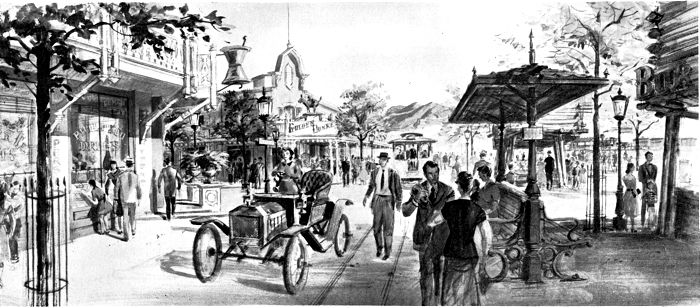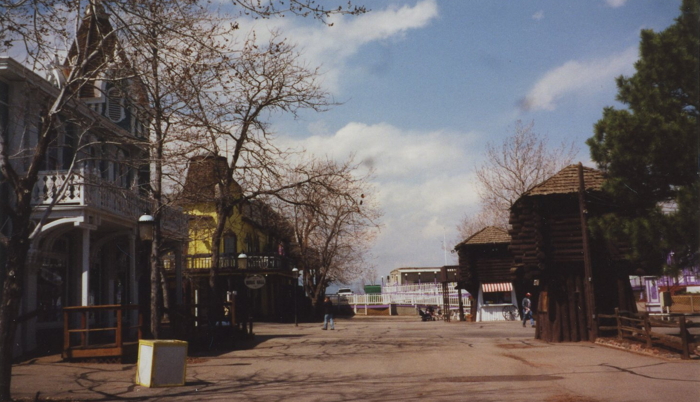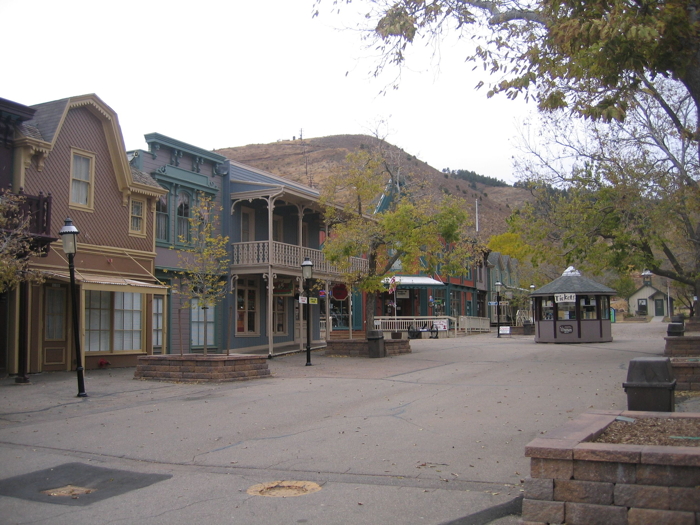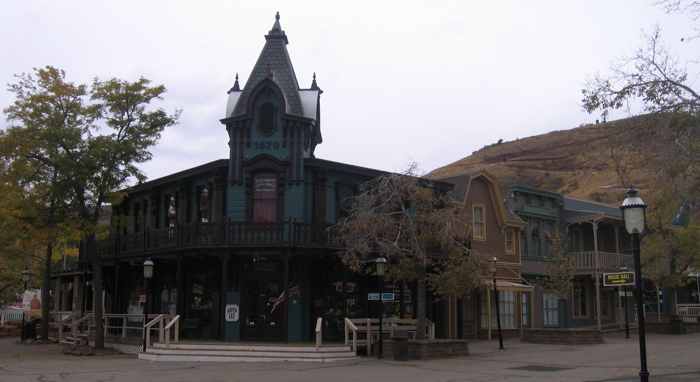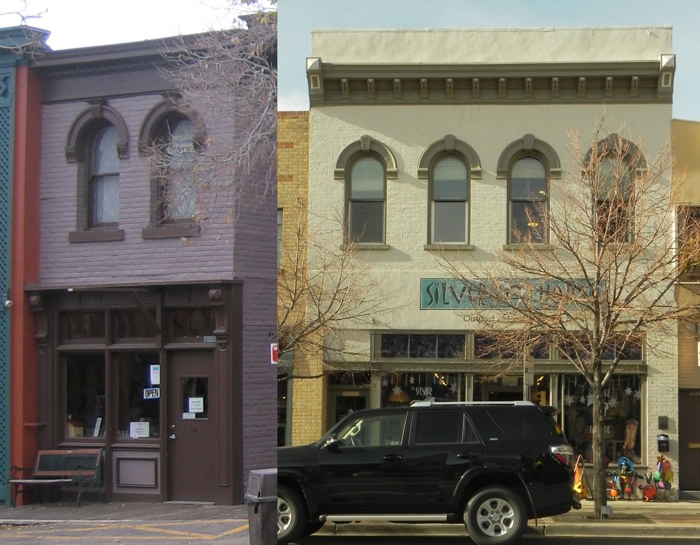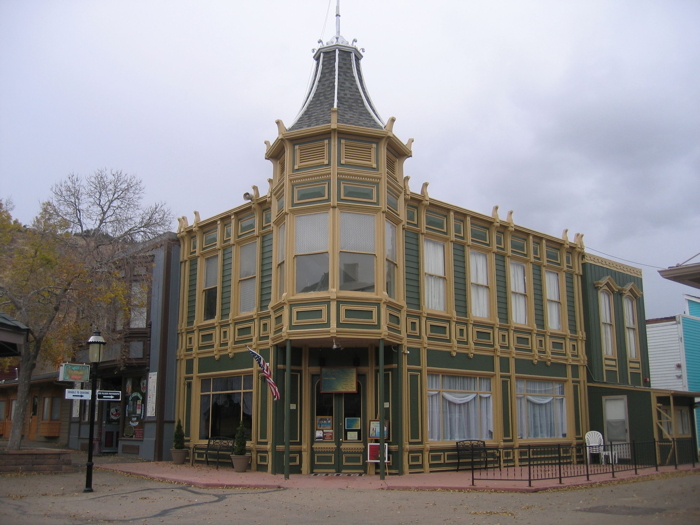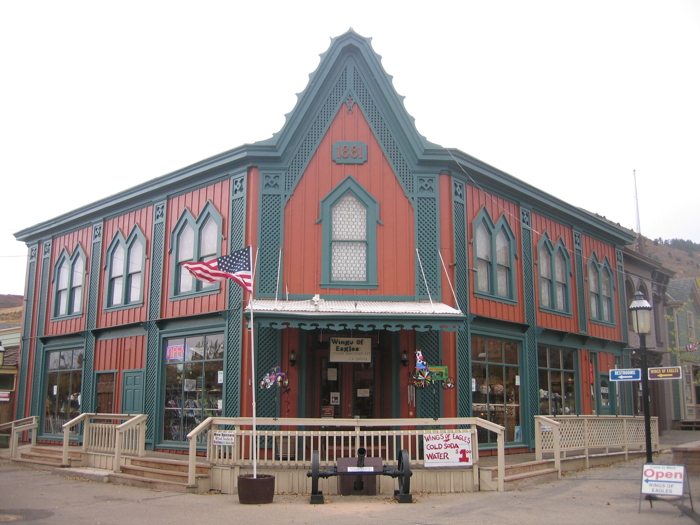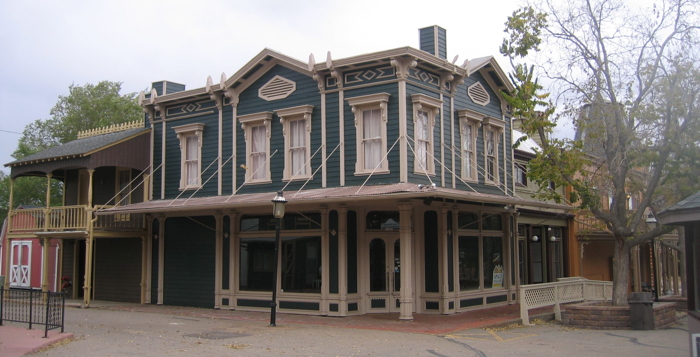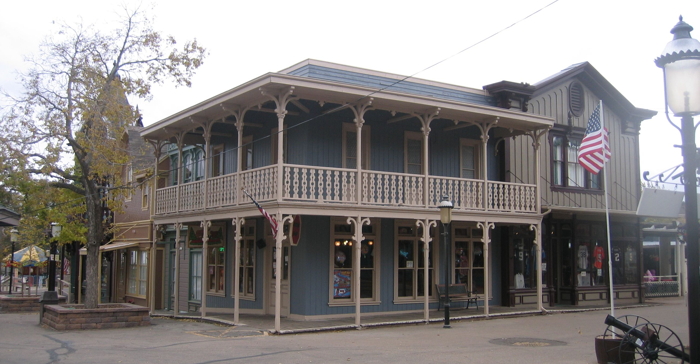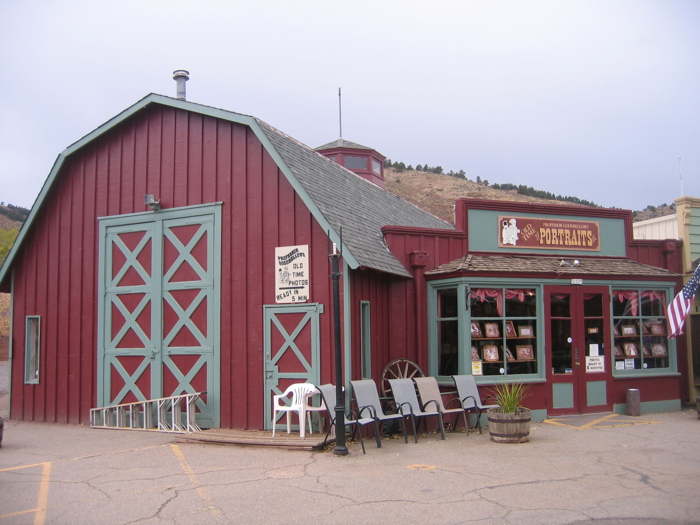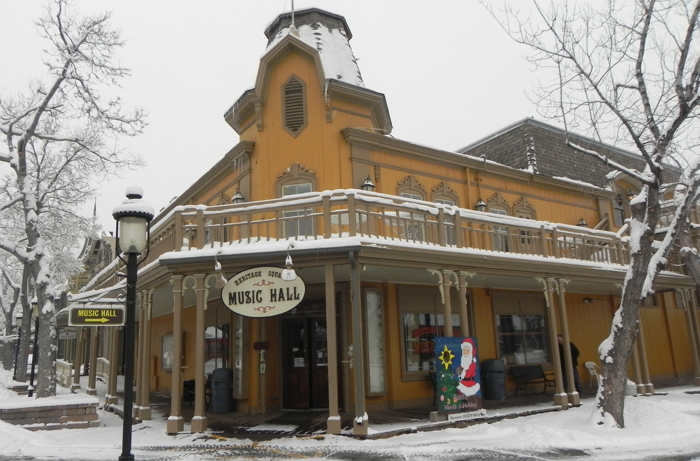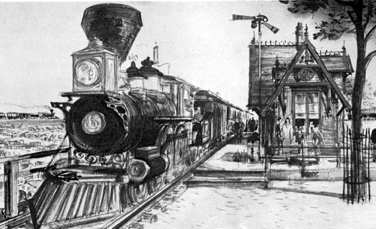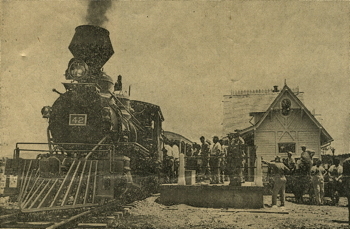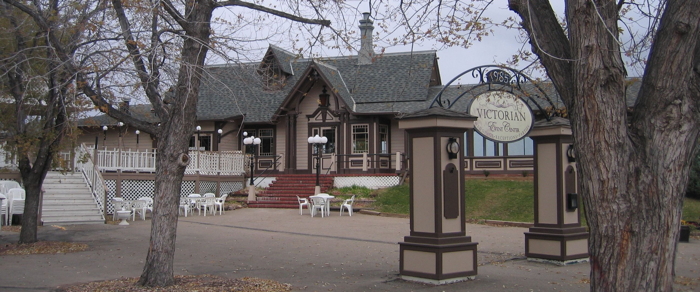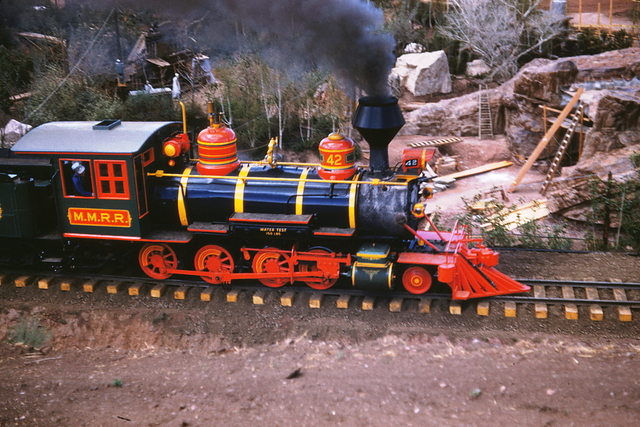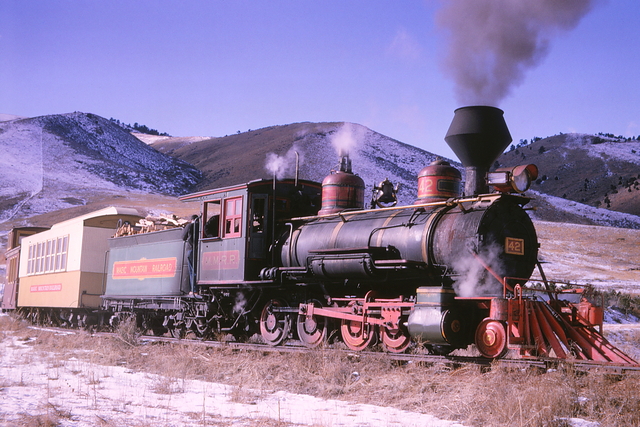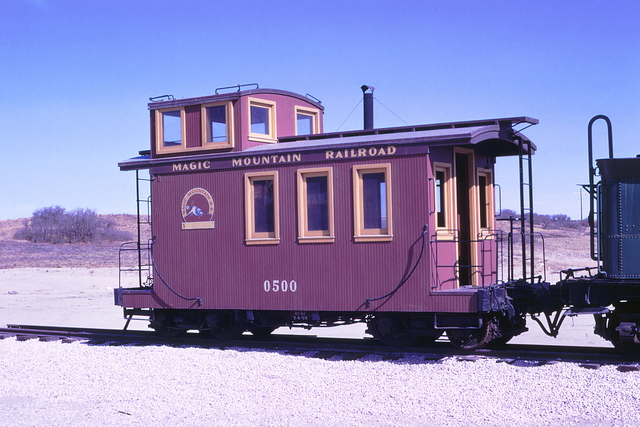
Above is the original artist's view and the reality looking northwest across the entry of Centennial City, towards the Golden Donkey, the building that ultimately became Heritage Square Music Hall. Centennial City's buildings, appearing as blocks of storefronts, were actually singular, 1-story steel-framed structures built with a number of different frame storefront facades on to make them appear like city blocks of individual buildings. Hollywood artisans had a considerable history of researching architecture to bring the distant and exotic to life on the screen, and Magic Mountain art directors Wade B. Rubottom and Dick Kelsey and their team went to work making detailed research into Colorado history to create buildings drawing upon historic styles from the region and Golden itself. These styles included Gothic Revival, Second Empire, Greek Revival, High Victorian Gothic, Dutch Gambrel, Pueblo Revival, Carpenter Gothic, and more.
Then Rubottom and Kelsey employed time-honored theatrical and cinematic arts to make their buildings truly exceptional and unique in the world. They crafted them in Storybook style, which Hollywood artists had successfully built in real life in Los Angeles area homes and Rubottom and Kelsey had successfully used helping create Main Street USA at Disneyland. Featured in the book "Storybook Style: America's Whimsical Homes of the Twenties", its authors state "Storybook Style houses were created by architets and builders with a flair for theater, a love of fine craftsmanship, and not least a sense of humor - attributes that make these homes endearing to the jaded modern eye." At Magic Mountain this style would now be captured in commercial form at Centennial City.
Built at 2/3rds scale to the blocks of downtown Golden, Centennial City employed several techniques taken from the silver screen to bring the movies to true life. Rubottom and Kelsey used the theatrical and screen art of forced perspective, to make Centennial City's buildings appear taller than they were by miniaturizing building elements as they went upward. In reality, their upper floors were really just 8-foot-wide hallways behind the facades. Moreover, a horizontal form of forced perspective was used, narrowing each storefront in accordion-like fashion to make each block appear longer than it actually was.
The facades had an exceptional degree of craftsmanship, using enhanced ornamentation, embellishments, and creative distortions to soften their appearance and give them an almost whimsical, gingerbread feeling. Their extensive woodwork, created under supervision of Director of Construction and veteran millworker Ralph G. Robinson, was custom milled on site. The intended result of the use of this workmanship and forced perspective was to give Centennial City a believable, but friendlier, scale and feeling than historic downtowns normally have.
The above image shows a Centennial City storefront compared to its apparent historic counterpart, the Dollison Building at 1114 Washington Avenue in historic downtown Golden. Magic Mountain used its artistic design techniques together with convenient 1950s-era storefront display styling to open its shops to the world. Concessionaires at Magic Mountain included Jerry Axtell (pony ride), Stanley Beigen (candy and toy store), Jeanette Brown (gift shop), Colorado Insurance Company (registry), Charles Dillner (burro and stagecoach), John Knight (penny arcade), George Masche (plastercraft shop), Joe Nimmo (trading post), Sampson Perlmutter (post office and print shop), and J.O. Turner (shooting gallery and photo shop).
Future Sarsaparilla Saloon, based on 2nd Empire style, with Gothic gargoyles on top
Based on Carpenter Gothic style
Future Metal Master, based on Greek Revival style
Centennial City Bank, where a "holdup" by the Larson Gang was staged every hour,
Magic Mountain Blacksmith Shop, now home to Professor Goodbellows old time portraits for over 30 years
Golden Donkey Saloon (which served soft drinks), based on 2nd Empire style The southern building at Centennial City's entrance was the Magic Mountain Play House. Its stage, still existing inside today, was an alcove stage at the west side of the venue, with curtain and footlights. It hosted a melodrama where the hero would save the ranch for the ranchman's daughter from the well-dressed villain in a top hat, accompanied dramatically by the nearby piano player. After the advent of Heritage Square in 1971 a group of comedy melodramatic players started in Estes Park in the early 1970s, led by G. William Oakley, took hold of the venue and became the Heritage Square Players, who hosted their own melodramas. In 1973 the Players moved across the street to what once was the Golden Donkey and retrofitted it as the Heritage Square Opera House, a unique comedy melodrama dinner theatre. They filled out a full second floor to the structure, which previously had been like all other Centennial City buildings. It hosted melodramas including long forgotten ones from the Victorian era, each followed by an olio of musical performance, all accompanied by the house pianist. When Oakley left and the Opera House shut down, actor T.J. Mullin and the players reopened the venue on June 1, 1988 by creating the Heritage Square Music Hall. It hosted its own comedic plays including melodramas and musical comedies, each followed by a musical revue. The Heritage Square Children's Theatre, led by Rory Pierce and also featuring the players, opened in 1993. It featured fun plays for children who often took part in the plays themselves. This widely renowned venue continued with many laughs until January 1, 2014, when the dinner theater closed its doors. At 25 years Heritage Square Music Hall was Jefferson County's longest live commercial performance venue under a single proprietor, and its building at 40 years the 2nd longest live commercial performance stage only to the Golden Opera House. Yet the story still does not end there, as what were the players of the Music Hall perform today as the Miners Alley Children's Theatre in downtown Golden.
A special Storybook Style edifice of this theme park was the Magic Mountain Railroad Depot. An ornate High Victorian Gothic structure, it was built overlooking the park's entrance, and far more impressive than any depot Jefferson County has seen to date. Concessionaire Tom Edge ran the snack bar inside the Magic Mountain railroad station.
From it ran a full scale narrow gauge train, the Magic Mountain Railroad, constructed to encircle the theme park using the historic Denver & Rio Grande Locomotive #42. Originally #420, it had been manufactured by the Baldwin works in 1889 and had served a fruitful career across Colorado, and was converted from steam to oil for fuel at Magic Mountain.
Magic Mountain Railroad in "Stagecoach To Seven" During the idle years after the theme park closed down the train came back to life in 1966, featured in the television pilot Stagecoach To Seven. The historic locomotive resumed service at Heritage Square in 1971 as part of the High Country Railroad, while the depot was converted into a restaurant and ultimately Victorian Event Center it is today. In 1975 the locomotive was replaced by an unusual engine, the Lima Shay 3118. This was a 10-ton shirt pocket 3 cylinder 2 truck Shay built in 1920, which departed from the company's usual practice of using Stephenson valve motion, instead using walshert motion for the valves and a common steam chest for all cylinders. This was retired in 1998, and the rail line was reconstructed as a miniature gauge of 15 inches. Thus the railroad was reborn as the Heritage Square Narrow Gauge Railroad (really narrow!), led by Denver & Rio Golden locomotive #463, a miniature steam engine of K-27 2-8-2 scale built by the Ulrich foundry in Strasburg, Colorado.
|
